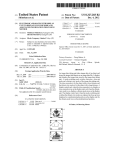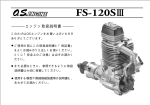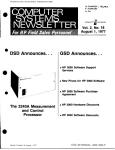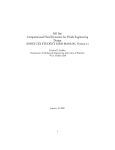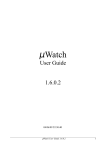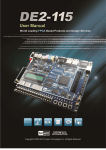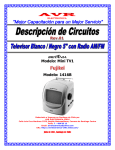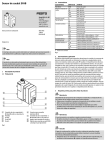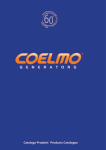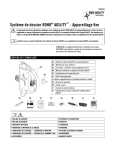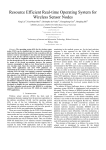Download Power adapter capable of communicating digitally with electronic
Transcript
US008261100B2 (12) United States Patent (10) Patent N0.: (45) Date of Patent: Paniagua, Jr. et a1. (54) (56) POWER ADAPTER CAPABLE OF COMMUNICATING DIGITALLY WITH ELECTRONIC DEVICES USING PACKET-BASED PROTOCOL (US); Parag Mody, Oakland, CA (US); Hossein Yassaie, Bucks (GB) (73) Assignee: Green Plug, Inc., San Ramon, CA (US) Notice: *Sep. 4, 2012 References Cited U.S. PATENT DOCUMENTS (75) Inventors: Frank Paniagua, Jr., San Ramon, CA (*) US 8,261,100 B2 5,488,572 A 6,029,215 A 1/1996 Belmont 2/2000 Watts et a1. 7,394,676 B2 * 7/2008 7,531,986 B2 * 5/2009 Eager et a1. . Patel ........................... .. 363/142 7,646,107 B2 * 1/2010 320/116 Smith ........................... .. 307/11 2006/0046653 A1 2006/0223579 A1 3/2006 Kirbas 10/2006 Whitaker et a1. 2010/0264875 A1* 10/2010 Hoffman et a1. ............ .. 320/111 OTHER PUBLICATIONS Subject to any disclaimer, the term of this patent is extended or adjusted under 35 American Power Conversion, 90-Watt-Hour Universal Notebook U.S.C. 154(b) by 1115 days. Battery (UPB90) User’s Manual, 2007.* PCT International Search Report, PCT/US2009/30149. This patent is subject to a terminal dis claimer. PCT Written Opinion of the International Searching Authority, PCT/ US2009/30149. * cited by examiner (21) Appl. No.: 11/969,163 Primary Examiner * Albert Wang (22) Filed: (74) Attorney, Agent, orFirm * DLA Piper LLP; Andrew B. SchWaab; Blake W. Jackson Jan. 3, 2008 (65) (57) ABSTRACT A poWer adapter capable of communicating digitally With a Prior Publication Data US 2008/0222431 A1 Sep. 11, 2008 device or a legacy adapter associated With a device is described. The poWer adapter includes an input port to receive Related US. Application Data poWer from a poWer source, a regulator to convert the received poWer from the poWer source, an output port con (63) Continuation-in-part of application No. 11/513,687, ?gured to deliver poWer from the regulator to a device, and a ?led on Aug. 30, 2006, noW abandoned. microprocessor con?gured to communicate digitally With a communication module associated With the device to deter (51) Int. Cl. (52) (58) US. Cl. ....................... .. 713/300; 320/114; 455/573 Field of Classi?cation Search ................ .. 320/114; G06F 1/26 mine the poWer requirements of the device. The regulator (2006.01) converts the poWer from the poWer source in accordance With the poWer requirements of the device. A related method of adapting poWer to a device is also described. 455/573; 713/300 See application ?le for complete search history. 90 Claims, 13 Drawing Sheets 102a Legacy 1021: Device Device ' Legacy Adapter Power Adapter Power Source 104 US. Patent Sep. 4, 2012 Sheet 1 0f 13 US 8,261,100 B2 102a Legacy 102b Device Device ' ' 0 Legacy 104 Adapter Power Adapter Power Source FIG. 1 106 US. Patent Sep. 4, 2012 Sheet 4 0113 US 8,261,100 B2 Device 102a1 : ___________ _ _l : Display i'*\/ 406 | _ _ _ _ _ _ _ _ _ _ _ _ _| 317a ‘g Microprocessor(s) '\/ 402 To Power Adapter 319 106 Ea Memory \, 408 Battery N 404 Temperature Sensor w 410 FIG. 4 104 ( 319c . < , PQAJLE'EZLZZSSOF K 502 Legacy Connector K 11 3 c 506 /-\/ K 504 Microprocessor Memory K 508 FIG. 5 US. Patent Sep. 4, 2012 Sheet 5 0113 US 8,261,100 B2 US. Patent Sep. 4, 2012 Sheet 6 0113 US 8,261,100 B2 700 Receive power from a 702 power source at an input J port l Communicate digitally 704 with the device l Determine the power requirements of the 706 J communication module l Convert the power from the power source in accordance with the 708 power requirements of the device l Deliver the converted power to the device through an output port FIG. 7 _/ US. Patent Sep. 4, 2012 Sheet 7 0113 US 8,261,100 B2 800 Receive an initial 802 predetermined voltage from the external power adapter 1 Communicate digitally 804 with the external power adapter to communicate at least a voltage requirement and a current requirement 1 Receive power supplied by the external power 806 adapter based on the power requirements of the device l Provide the received 808 J power to the electrical device FIG. 8 900 902 \ Transmission Start 904 \ Vendor ldentifer 906 \ Message Type WW 1 byte 4 bytes 1 byte 908 91 0 \ Payload Y Variable size FIG. 9 91 2 \ Checksum 1 Y 2 bytes \ Transmission End 1 Y 1 byte 1 US. Patent Sep. 4, 2012 Sheet 8 0113 US 8,261,100 B2 1000 Q 1002 /// \\~____\ I. // \\\\ Receive message 1004 1006 Error OK 100 Proprietary message Unrecognized 1010 Power statement FIG. 10 1012 US. Patent Sep. 4, 2012 Sheet 9 0113 US 8,261,100 B2 1100 Enter communication Receive timeout Transmission attempts = 8 1 102 Receive Backoff message Verify Checksum 1110 Exit communication FIG. 11 US. Patent Sep. 4, 2012 Sheet 13 0113 US 8,261,100 B2 1302a DC In 1304a ( / josa Fixed Regulator ‘sense 1308a 1302b 1304b ( / 1306b Fixed Regulator ‘sense 1308b 1302c 1304c ( Adjustable 1306c / / Regulamr lsense —> 13080 From Microprocessor if 1312 PWM In FIG. 13 1310 VREF 1409 1402 l 1 ) 1418 \J 14(14a , [189% AC In > Fixed Regulator 1404 Aélvgc 1416a 1416b 1414b / I / > Fixed Regulator I 1408 / 1414c / ( Adjustable '/ b 1406 Y 1416c Regulator 1410 \ Digital Comm‘ : To Device —> US 8,261,100 B2 1 2 POWER ADAPTER CAPABLE OF COMMUNICATING DIGITALLY WITH ELECTRONIC DEVICES USING PACKET-BASED PROTOCOL the poWer source in accordance With the poWer requirements of the device, and delivering the converted poWer to a device through an output port. According to some embodiments, a poWer adapter includes an input port to receive poWer from a poWer source, one or more regulators to convert poWer from the poWer source, a RELATED APPLICATIONS plurality of output ports con?gured to deliver poWer from the This application claims priority to and is a continuation in-part of US. patent application Ser. No. 11/513,687, noW one or more regulators to a plurality of devices, and a micro processor con?gured to communicate digitally With a respec tive communication module associated With a respective device to determine poWer requirements of the respective abandoned titled “Power Supply Capable of Receiving Digi tal Communications from Electronic Devices,” ?led Aug. 30, 2006, Which is incorporated by referenced herein in its device. One of the one or more regulators converts the poWer entirety. from the poWer source in accordance With the poWer require ments of the respective device. According to some embodiments, a method of adapting poWer to a plurality of devices includes receiving poWer from a poWer source at an input port, communicating digitally With TECHNICAL FIELD The disclosed embodiments relate generally to poWer adapters, and more particularly, to a poWer adapter that is capable of communicating digitally With devices to be poW ered by the poWer adapter. a communication module associated With a respective device 20 poWer source in accordance With the poWer requirements of BACKGROUND the respective device, and delivering the converted poWer to the respective device through one of a plurality of output Consumer electronic devices are ubiquitous in the World We live in today. From laptop computers and personal digital assistants to multimedia players and mobile phones, people 25 30 other. If a user loses a poWer supply for a device, the poWer supply of another device generally cannot be used as a sub stitute. This causes many problems. Travel is made more 35 adapter through a port of the electrical device, the poWer requirements including at least a voltage requirement and a current requirement. According to some embodiments, a method of receiving device includes receiving an initial prede?ned voltage to facilitate communication betWeen the external poWer adapter 40 be discarded as Well because users often do not have other devices that are compatible With these poWer supplies. Accordingly, What is needed is a poWer adapter that can communicate digitally With and be used to poWer a Wide variety of devices. sor, housed in the electrical device, con?gured to communi cate digitally With an external poWer adapter to communicate poWer requirements of the electrical device to the poWer poWer from an external poWer adapter external to an electrical inconvenient by the prospect of having to bring multiple poWer supplies for various portable devices. A device may be damaged and/or its useful life shortened if the Wrong poWer supply is used. Furthermore, as devices become obsolete and are discarded by users, the poWer supplies for the devices may ports. According to some embodiments, a communication mod ule for use With an electrical device includes a microproces today oWn a Wide variety of electronic devices. These elec tronic devices come With a Wide variety of poWer supplies, sometimes referred to as “Wall Warts,” “poWer bricks,” or “poWer adapters.” Unfortunately, these poWer supplies are often speci?c to the device type, device manufacturer, and/or device product line, and are therefore incompatible With each of the plurality of devices to determine the poWer require ments of the respective device, converting poWer from the 45 and the electrical device, communicating digitally With the external poWer adapter to communicate poWer requirements of the electrical device to the external poWer adapter through a poWer port of the electrical device, and receiving poWer supplied by the external poWer adapter based on the poWer requirements of the electrical device. The poWer require ments include a voltage requirement and a current require ment. SUMMARY BRIEF DESCRIPTION OF THE DRAWINGS The above de?ciencies and other problems associated With poWer supplies are reduced or eliminated by the disclosed poWer adapter and an electronic device that are capable of digital communications With each other. 50 ments. FIG. 2 is a schematic illustrating a poWer adapter in accor dance With some embodiments. According to some embodiments, a poWer adapter to pro vide poWer to a device includes an input port to receive poWer from a poWer source, a regulator to convert the received 55 poWer from the poWer source, an output port con?gured to deliver poWer from the regulator to the device, and a micro processor con?gured to communicate digitally With a com munication module associated With the device to determine poWer requirements of the device. The regulator converts the FIG. 1 is a block diagram of a poWer adapter coupled to a poWer source and devices in accordance With some embodi FIG. 3 is a schematic diagram of a poWer adapter coupled to devices, a poWer source, and a legacy adapter in accordance With some embodiments. FIG. 4 is a schematic illustrating a device in accordance With some embodiments. 60 FIG. 5 is a schematic illustrating a legacy adapter in accor poWer from the poWer source in accordance With the poWer dance With some embodiments. requirements of the device. FIGS. 6A-6C are schematics illustrating a poWer adapter coupled to a device, a legacy adapter, or a client in accordance According to some embodiments, a method of adapting poWer to a device includes receiving poWer from a poWer source at an input port, communicating digitally With a com munication module associated With the device to determine poWer requirements of the device, converting the poWer from With some embodiments. 65 FIG. 7 is a How diagram illustrating a method of adapting poWer to one or more devices in accordance With some embodiments. US 8,261,100 B2 4 3 poWered by the poWer adapter 106. The external poWer FIG. 8 is a How diagram illustrating a method of receiving adapter 106 may be electrically coupled to one or more power from an external power adapter external to an electrical device in accordance With some embodiments. FIG. 9 is a diagram illustrating a packet structure of a devices 102 via poWer cords, cables, induction, or other knoWn Ways of transmitting poWer (not shoWn). In some embodiments, both the poWer adapter 106 and a device 102a digital communication betWeen the poWer adapter and a legacy adapter or a device in accordance With some embodi conform to a common connector or interface standard; the ments. poWer cord coupling the poWer adapter 106 to a given device, such as device 102a includes standardized connectors on one FIG. 10 is a state diagram illustrating digital communica or both ends of the cord, and may, in some embodiments, be non-detachably a?ixed to the poWer adapter 106 on one end. A device 102a may be designed to use the standardized con nector and be coupled to the poWer adapter 106 via a cord tion states of a poWer adapter in accordance With some embodiments. FIG. 11 is a state diagram illustrating digital communica tion states of a client in accordance With some embodiments. FIGS. 12A-C are circuit schematics illustrating a PFC Controller in accordance With some embodiments. plugs and receptacles, the poWer adapter 106 can serve as a FIG. 13 is a circuit schematic illustrating regulators in universal poWer adapter to any device that is designed to having the standardized connectors. By using standardized include a standardized plug or receptacle, such as a multi purpose poWer connector. accordance With some embodiments. FIG. 14 is a schematic diagram illustrating a poWer adapter including AC/DC converters and regulators in accordance With some embodiments. Like reference numerals refer to corresponding parts 20 throughout the draWings. DESCRIPTION OF EMBODIMENTS Reference Will noW be made in detail to embodiments, 25 With the legacy device 1021). examples of Which are illustrated in the accompanying draW ings. In the folloWing detailed description, numerous speci?c In some embodiments, the legacy adapter 104 is a part of a details are set forth in order to provide a thorough understand cord that includes the multi-purpose poWer connector on one end and legacy adapter 104 on the other end, Which includes ing of the present invention. HoWever, it Will be apparent to one of ordinary skill in the art that the present invention may In some other embodiments, the poWer adapter 106 and legacy device 1021) use different types of poWer connectors. For example, a device that is not designed to use the multi purpose poWer connector (e.g., an older device) may have a legacy poWer connector that is device- or manufacturer-spe ci?c and not conforming to the standard that is used by the poWer adapter 106. In such embodiments, the use of a legacy adapter 104 may be used to interface the poWer adapter 106 30 a device- or manufacturer-speci?c connector. Accordingly, the poWer adapter 106 may be coupled directly to legacy be practiced Without these speci?c details. In other instances, Well-known methods, procedures, components, and circuits device 102b via a cord that includes the multi-purpose poWer have not been described in detail so as not to unnecessarily connector on one end and legacy adapter 1 04 on the other end. In other Words, the cord is customized to the connector on the obscure aspects of the embodiments. FIG. 1 is a block diagram of a poWer adapter coupled to a 35 device because at least one connector on the cord is device- or poWer source and devices in accordance With some embodi ments. PoWer source 108 supplies electrical poWer to poWer manufacturer-speci?c. adapter 106 in order to supply electrical poWer to devices 102. The poWer source 108 may provide alternating current (AC) or direct current (DC) voltage. In some embodiments, the dongle, may be coupled to legacy device 1021). The dongle In some other embodiments, an attachment, such as a 40 includes legacy adapter 104 to “convert” the connector on legacy device 1021) to the standardized connector utilized by poWer adapter 106 (i.e., the multi-purpose poWer connector). poWer source 108 is a poWer outlet, such as a Wall outlet. The poWer outlet voltages outside the United States. In other When using a dongle that includes legacy adapter 104, a cord embodiments, the poWer source 108 is an outlet in an airplane armrest or in an automobile, such as a cigarette lighter socket, With a multi-purpose poWer connector on both ends may be Which typically provides 12V DC. In still other embodiments, 45 the poWer source 108 is anAC/DC converter that receives an AC input and provides a DC output to the poWer adapter 106. In further embodiments, the poWer source is a motor, genera tor, battery, etc. that provides electricity. Depending on the particular embodiment, the poWer adapter 106 may be con used. One end of the cord couples to the multi-purpose poWer connector of poWer adapter 106 and the other end couples to a dongle that includes legacy adapter 104. The other end of the dongle contains the device- or manufacturer-speci?c con nector for coupling to legacy device 1021). In other Words, the dongle With legacy adapter 104 contains both a multi-purpose 50 poWer connector and a device- or manufacturer-speci?c con nector, thereby alloWing coupling of the poWer adapter 106 ?gured for coupling to only a DC poWer source, only an AC poWer source, or either a DC or AC poWer source. The poWer and legacy device 1021) via a cord having the multi-purpose adapter 106 thus functions as anAC/DC converter, a DC/DC converter, or both, depending on the embodiment. The poWer adapter 106 may be coupled to the poWer source 108 via a poWer connector on the device end of the cord. FIG. 2 illustrates poWer adapter 106 of some embodiments. 55 poWer cord, cable, induction, or other knoWn Ways of trans adapter 106 has multiple output ports 204 (e.g., 204a, 204b, mitting poWer. and 2040). Input port 202 and output ports 204 can be any The poWer adapter 106 may be coupled to one or more devices 102. The devices 102 may include any of a variety of electronic devices, including but not limited to consumer combination of plugs, receptacles, sockets, magnetic poWer 60 connectors, non-detachable cords, etc. In one embodiment, the output ports 204 include a receptacle for receiving the electronic devices, cellular phones, multimedia devices, com puter devices and peripherals. PoWer adapter 106 may come in a variety of sizes. For example, poWer adapter 106 may be implemented in a relatively small size for ease of portability and travel convenience. In some embodiments, the poWer adapter 106 is a standa lone unit, external to and distinct from devices 102 to be PoWer adapter 106 includes an input port 202 for receiving poWer from a poWer source, e.g., poWer source 108. PoWer multi-purpose poWer connector. In another embodiment, one or more cords are non-detachably ?xed to one or more output ports 204. PoWer adapter 106 may also include a user inter 65 face for interaction With a user. In some embodiments, the user interface comprises a status light 206 (e.g., 206a, 206b, and 2060) associated With each output port 204 that may US 8,261,100 B2 5 6 indicate whether a device is being powered, whether the device is being provided reduced power, or other statuses of FIGS. 12A-C. PFC Controller outputs DC power through switches 320 to regulators 318a, 318b, and 3180 via PFC power lines 305a, 305b, and 3050, respectively. In some embodiments, switches 320 are internal to regulators 318 and power adapter 106 or devices 102 connected to the power adapter 106. Status lights 206 can indicate one or more sta tuses by blinking, changing colors, or the like. The user inter face of power adapter 106 may also include display 208, operate as an ENABLE/DISABLE line to disconnect the which may be an LCD screen, an LED, or an OLED display for displaying information to a user. In some embodiments, described in more detail below with reference to FIG. 13. In output of regulators 318. An example of this embodiment is some embodiments, regulators 318 are programmable status information can be displayed on display 208 in addition to or in place of status lights 206. For example, the back switching regulators. In some other embodiments, regulators 318 are programmable linear regulators. The switches 320 are used to disconnect each regulator 318 that is not currently in ground color of display 208 could change colors or blink based on the status of the devices 102 or the power adapter 106. In other embodiments, where device 102 includes a use by a device 102 from PFC power lines 305. In some display 406 as illustrated in FIG. 4, power adapter 106 may instruct device 102 to display certain information on the display 406 of device 102. Display 406 may be an LCD embodiments, when the battery of device, e.g., device 102a1, has completed charging, device 102a1 noti?es power adapter 106 that the battery is fully charged and microprocessor 306 screen, an LED, or an OLED display. opens switch 32011 to disconnect regulator 31811. When dis connected, the regulators 318 do not draw power from the PFC Controller 304 and thereby the switches 320 allow for a Furthermore, additional information about power adapter 106 may be displayed on display 208. The user interface of power adapter 106 may also include an input device so that a user can interact with power adapter 106. An example of an input device is button 210. Button 210 may be used in con 20 nection with display 208 to allow a user to access information power source 108. In some embodiments, one or more regu about power adapter 106, any of the attached devices, and/or to program or otherwise interact with power adapter 106. For 25 example, display 208 may provide information about the operating mode or charge mode of power adapter 106, current load and capacity information of each output port 204 and/or of power adapter 106, the current time, etc. Display 208 may also show information about the devices currently and or previously connected to power adapter 106 such as, device 30 identi?cation information, device power requirements, device battery identi?cation information, device battery con dition information, etc. When a battery in device 102 is being charged, display 208 may indicate the amount of time left 35 until the battery is fully charged. the charge mode of power adapter 106 (the operating mode and charge modes are described below with reference to 40 could be used, for example, to allow a user to more easily interact with power adapter 106 or to provide access to more features or information. For example, the user interface of power adapter 106 may include multiple control menus each tional) surge protector 302. The (optional) surge protector 45 or software program. Various subsets of these modules may be combined or otherwise re-arranged in various embodi ments. Microprocessor 306 may be, for example, PIC24FJ64GA004-I/PT (Microchip Technology Inc. PIC24 16-bit Microcontroller). 50 Communication module 310 communicates digitally with devices 102a (e.g., 102111 and 102112) or legacy adapter 104 55 via communication lines 317. Communication module 310 could be designed to use I2C or any other physical-layer bus known in the art. The speci?c physical-layer bus used is not important to the invention. If the power adapter 106 is con nected to a device 10211 through the device’ s Universal Serial 60 Bus (“USB”) port, then the digital communication of the device 10211 is directed through USB communication inter face adapter 314. The USB communication interface adapter 314 may be, for example, CY7C67200 (Cypress Semicon ductor EZ-OTGTM Programmable USB On-The-Go Host/ 65 Peripheral Controller). Switch/MUX 316 connects commu nication module 310 directly to communication lines 317 or USB communication interface adapter 314 to communication lines 317 depending on whether USB communication is needed in order to communication with device 10211 or legacy 302, which is well known in the art, may be included in power adapter 106 for protection against power surges or electrical spikes. In some embodiments, power source 108 supplies AC elec trical power that is fed into Power Factor Correction (“PFC”) Controller 304, which converts the power from AC to DC. An exemplary circuit for PFC Controller 304 is illustrated in tions associated with each of the above identi?ed modules, which are described below, may be implemented in hardware, ?rmware, or software, and may correspond to sets of instruc tions for performing the functions. The above identi?ed mod ules need not be implemented as separate modules, proce dures, or software programs; instead, two or more of the other input devices are used in place of or in conjunction with button 210. For example, display 208 could be a touch screen and thus allow input from a user. Other forms of input devices FIG. 3 is a schematic diagram of power adapter 106 includ ing devices 102, power source 108, power cords 322, and legacy adapter 104 in accordance with some embodiments. Power adapter 106 is connected to devices 102a and legacy adapter 104 via power cords 322a, 3221) and 3220, respec tively. In some embodiments, power cords 322 have a multi purpose power connector on each end. Power adapter 106 receives electrical power from power source 108 into (op across multiple microcontrollers, integrated circuits, and/or microprocessors. For example, memory 307 may be imple modules may be implemented in a single module, procedure, with one or more control functions. In some embodiments, include a scroll wheel, dial, knob, joystick, trackball, and 5-way switch. lators 318 are ?xed-voltage regulators, e.g. operating at a ?xed output of 5 volts. A microcontroller, e. g., microprocessor 306, includes memory 307, power control module 308, communication module 310, user interface module 311, and temperature module 312. However, as would be appreciated by one of skill in the art, memory 307, power control module 308, commu nication module 310, user interface module 311, and tem perature module 312 do not have to be in a single microcon troller, but instead, the functions related to each can be spread mented as a separate memory device. Furthermore, the func Button 210 could also be used to set the operating mode or FIGS. 1-5). Although only one button 210 is shown, it is contemplated that multiple buttons or other control interfaces reduction in wasted electrical power. In some embodiments, a DC-DC converter may be used instead of or in addition to PFC Controller 304 for use with a DC power source, eg adapter 104. Alternatively, USB communication module 310 could be contained within communication module 310 or US 8,261,100 B2 7 8 could replace communication module 310 if only USB com tion; poWer adapter 106 could have one or more output ports 204, e.g., more than 3, each With a device 10211 or a legacy munications Were needed. In Which case, sWitch/MUX 316 Would not be needed. Communication lines 31711 and 31711 are in digital com device 102!) coupled thereto. FIG. 4 is a schematic of device 102111 in accordance With some embodiments. As shoWn in FIG. 4, poWer line 31911 and munication With devices 10211 and communication line 3170 communication line 31711 couple poWer adapter 106 to device is in digital communication With legacy adapter 104. The devices 10211 and legacy adapter 104 communicate the poWer requirements of devices 10211 and legacy devices 102b, respectively, to microprocessor 306. The poWer requirements 102111. In some embodiments, poWer line 31911 and commu nication line 31711 are provided by poWer cord 32211. Device 102111 includes one or more microprocessors 402, and a bat tery 404. In some embodiments, battery 404 is a rechargeable battery. Communication line 31711 is connected to micropro cessor 402 of device 102111. Microprocessor 402 communi cates the initial poWer needs of device 102111. In some embodiments, microprocessor 402 communicates can include one or more of voltage, current or Wattage requirements of the devices 102. In some embodiments, the voltage requirements include three values: a nominal voltage, a negative tolerance, and a positive tolerance, Which creates a WindoW of voltage values. Similarly, the current and/ or Watt age requirements can include nominal values and negative and positive tolerances. Based on the poWer requirements of the poWer needs of device 102111 on a near real-time basis. each device 102, poWer control module 308 instructs regula munication line 31711 in regular communication intervals, Device 102111 communicates its poWer requirements from microprocessor 402 to communication module 310 via com tors 318 to deliver the requested poWer output to the device through poWer lines 319. e.g., every 30 seconds. Based on each of these communica 20 There is a separate poWer line 31911, 319b, or 3190 associ to device 102111. In some embodiments, When operating on a ated With each regulator 318 and, consequently, With each device 102. Each regulator 31811, 318b, and 3180 is indepen dent of each other and can provide the speci?c poWer require ments of the device 102 associated With the respective regu lator 318. PoWer control module 308 instructs each regulator 318 separately via the control line 309 associated With the near real-time basis, poWer adapter 106 only provides poWer to device 102111 for one communication interval, eg 30 25 poWer control module 308 instructs regulator 31811 via con communication betWeen communication module 310 and legacy adapter 104. Legacy adapter 104 Will be discussed in 30 charged. Microprocessor 402 may perform this calculation 35 cessor 402 and memory 408 can be used to keep track of the 40 45 module 312 communicates With a temperature sensor (not shoWn) contained in poWer adapter 106. The temperature sensor in poWer adapter 106 measures the temperature of the poWer adapter 106. Temperature module 312 receives the temperature information from the temperature sensor. This temperature information can then be displayed to the user based on the present voltage and current draWn by battery 404 and the charging pro?le of battery 404, Which may be pre programmed into microprocessor 402. In addition, micropro perature module 312. Temperature module 312 can be used to monitor the temperature of poWer adapter 106. Temperature poWer adapter 106 along With other battery condition infor mation. For example, microprocessor 402 can calculate the charge level of battery 404 as a percentage of the capacity of battery 404 or the amount of time until battery 404 is fully more detail beloW With respect to FIG. 5. In some embodiments, communication line 317 and poWer line 319 are both contained in the same poWer cord 322 to connect poWer adapter 106 to device 10211, poWer adapter 106 to legacy device 1021) (cord not shoWn), or poWer adapter 106 to legacy adapter 104, Which connects to legacy device 1021). In some embodiments, microprocessor 306 includes tem seconds, and Will not continue to provide poWer unless micro processor 402 communicates the present poWer requirements of device 102111 to communication module 310 before the end of that communication interval. In some embodiments, microprocessor 402 can read the voltage on battery 404 and communicate that information to regulator (e.g., 30911, 309b, and 3090). Thus, for example, trol line 30911 to provide the speci?c poWer requirements of device 102111 through poWer line 31911. Similarly, legacy device 1021) Will receive the poWer requirement of legacy device 1021) through legacy adapter 104 based on the digital tions, regulator 31811 provides the requested amount of poWer 50 number of times battery 404 has been fully charged in order to adapt the charge pro?le of battery 404 over the life of the battery. The number of times battery 404 has been fully charged may also be used to estimate the remaining life of the battery. Microprocessor 402 may communicate all of this battery condition information to poWer adapter 106. In other embodiments, a separate integrated circuit, such as a “gas gauge IC,” (not shoWn) may be in communication With micro processor 402 and perform the aforementioned functions, namely read the voltage on battery 404, calculate the charge level of battery 404, calculate the amount of time until battery 404 is fully charged, and store the charging pro?le of battery 404. through, for example, display 208. In some embodiments, the temperature information obtained by temperature module In some embodiments, the battery condition information The user interface module 311 is connected to the status includes a temperature measured by a temperature sensor 410 in the device 102111. The temperature sensor 410 may be a discrete component or may be integrated into another com ponent, such as the microprocessor 402 or another IC. In lights 206, button 210, and display 208. The user interface module 311 processes the input provided by the user through, some embodiments, the poWer adapter 106 determines the level of poWer to provide to the device 102111 in accordance 3 12 is used in connection With the round-robin charging mode described beloW. for example, button 210. As explained above, the user can select different modes of poWer adapter 106 or select to dis play various information about the poWer adapter 106, or the devices 102. This information can be displayed on display 208 and/ or by activating status lights 206 and may be stored in memory 307. FIG. 3 illustrates tWo devices 102111 and 102112 and a legacy device 102!) coupled to poWer adapter 106. It shouldbe noted that poWer adapter 106 is not limited to this con?gura 55 With the measured temperature. For example, if the measured 60 temperature is beloW a ?rst speci?ed temperature, a “fast charge” mode is enabled in Which a higher than normal level of poWer is provided to the device 10211. In another example, if the measured temperature exceeds a second speci?ed tem perature, the level of poWer provided to the device 102111 is 65 reduced or terminated. As described above, devices 102 that can be electrically coupled to the poWer adapter 106 encompass a variety of US 8,261,100 B2 9 10 electronic devices, including but not limited to consumer adapter 106. Similarly, the Wake-up voltage may facilitate digital communication betWeen the legacy adapter 104 and electronic devices, cellular phones, multimedia devices, com puter devices and peripherals. Some of these devices 102 may poWer adapter 106 and thus be provided before digital com munications take place. The Wake-up voltage may be pro vided directly to microprocessor 402 or microprocessor 506 include a battery or batteries 404 and some may not. The battery (or batteries) 404 may be rechargeable or non-re chargeable. Examples of rechargeable battery technologies of legacy adapter 104. The Wake-up voltage poWers the include lithium-ion batteries, nickel cadmium batteries, and microprocessors 402 or 506 facilitating the microprocessors nickel metal hydride batteries. Examples of non-rechargeable battery technologies include alkaline and lithium batteries. 402 or 506 to initiate digital communications With commu nication module 310 to communicate the poWer requirements of the devices 102 to poWer adapter 106 via communication line 317. With reference to FIGS. 1-5, poWer adapter 106 may pro vide poWer to multiple devices 102 simultaneously to operate the devices 102 and/or charge batteries 404 of the devices 102. It is possible that the total poWer requirements of all of the attached devices 102 exceeds the amount of poWer that poWer adapter 106 can provide, thus causing an overload For a device 102 that does not have a battery 404 or that has non-rechargeable batteries, the poWer supplied by the poWer adapter 106 merely poWers the device 102 for operation. For a device 102 that has a rechargeable battery 404, the poWer supplied by the poWer adapter 106 poWers the device 102 for operation and/ or recharges the battery 404. As it is knoWn in the art, different devices and batteries have different poWer requirements for operation and/or battery charging. Thus, the condition. PoWer adapter 106 may operate in multiple differ poWer adapter 106 needs to knoW the poWer requirements of the devices 102, in order to supply the proper amount of poWer. ent charge modes either on user request or to handle an 20 overload condition, such as priority charging, reduced poWer FIG. 5 is a schematic of legacy adapter 104 in accordance With some embodiments. Legacy adapter 104 includes a charging, and/ or round-robin charging modes. In some embodiments, poWer adapter 106 operates in more than one multi-purpose poWer connector 502, microprocessor 506, of these modes simultaneously. and legacy connector 504. Multi-purpose poWer connector 502 is adapted to connect With another multi-purpose poWer connector (not shoWn), Which does not mate electrically and/ In priority charging mode, poWer adapter 106 supplies 25 poWer to one or more of the attached devices 102 that have a higher priority than the other attached devices 102. In some embodiments, each device 102 has a different priority level associated With it, Which has been pre-programmed into poWer adapter 1 06. In some other embodiments, there may be or physically With the connector on legacy device 1021). Legacy device 1021) has a legacy poWer connector that is device- or manufacturer-speci?c and thus, does not conform to the standard that is used by poWer adapter 106, e.g., the multi-purpose poWer connector. Legacy connector 504 is adapted to connect to the device- or manufacturer-speci?c connector of legacy device 1021). Microprocessor 506 com municates digitally With communication module 310 of poWer adapter 106 via communication line 3170 in order to 30 separate priority level for each output port 204. In some embodiments, a user speci?es priority levels for respective output ports 204, for example by using an input device such as 35 provide poWer adapter 106 With the poWer requirements of legacy device 1021). In some embodiments, legacy adapter 104 includes memory 508 to store the poWer requirements of legacy device 1021) and possibly other information relating to legacy device 1021). Memory 508 could be ?ash memory, an EEPROM, or may be embedded in microprocessor 506. Because legacy adapter 104 is device- or manufacturer-spe ci?c, it can be pre-programmed With the poWer requirements of legacy device 1021). In some embodiments, legacy adapter 104 can be programmed by poWer adapter 106 to update or change the poWer requirements of the associated legacy device 1021). In some embodiments, legacy adapter 104 does not include microprocessor 506. In these embodiments, memory 508 stores the poWer requirements of legacy device 102b, and microprocessor 306 of poWer adapter 106 reads the poWer requirements of legacy device 1021) directly from memory 508 of legacy adapter 104. 40 a button 210. PoWer adapter 106 provides poWer to as many attached devices as it can in order of priority level and based on the poWer requirements of each device. In further embodi ments, each device 102 has either a high priority or a loW priority and poWer adapter 106 provides poWer to each attached device 102 With high priority. Once the poWer requirements of the devices 102 With high priority has loW ered, for example, because battery 404 of device 102 has completed charging, poWer adapter 106 Will begin to provide poWer to the attached devices 102 With loW priority. In reduced poWer charging mode, poWer adapter 106 pro 45 vides a reduced amount of poWer to each of the attached devices 102. For example, if an attached device 102 is in a standby mode as opposed to being fully operational and the 50 After the poWer requirements are communicated to poWer adapter 106, as described above, poWer control module 308 adjusts the poWer output of regulator 3180 to deliver the requested amount of poWer. Thus, regulator 3180 delivers the a set number ofpriority levels, e.g., 2 or 5, or there may be a poWer requirements of the device are mainly associated With charging of the battery 404 of the attached device 102, then the attached device 102 is capable of receiving a reduced amount of poWer compared to the poWer that the device 102 is requesting. The reduced poWer may cause battery 404 of device 102 to take longer to charge, but the attached device 102 can still function even at a reduced poWer. Sometimes an 55 attached device 102 Will need all of the poWer it is requesting to operate. In some embodiments, poWer adapter 106 Will required poWer to legacy device 1021) through legacy adapter determine Whether an attached device 1 02 can handle reduced 104 via poWer line 3190 in accordance With the poWer poWer and only supply reduced poWer to the attached devices requirements of legacy device 1021). In some embodiments, as discussed above, the poWer output of regulator 3180 is 102 that are able to handle the reduced poWer. For example, 60 adjusted on a real-time basis. With reference to FIGS. 4 and 5, in some embodiments, regulator 31811 of FIG. 3 also provides a prede?ned Wake-up voltage to devices 102a and/or legacy adapter 104. In some embodiments, the prede?ned voltage is +5 V. The Wake-up voltage may facilitate the poWering-on of a device 102a and/ or digital communication betWeen the device 102a and poWer the attached device 102 may provide poWer adapter 106 With tWo poWer requirements, a preferred poWer requirement and a minimum poWer requirement (e. g., a poWer requirement for operating device 102 and charging battery 404, and a poWer requirement for just operating device 102). Alternatively, 65 attached device 102 may provide voltage and current require ments that include a nominal value, a negative tolerance, and a positive tolerance, thereby creating a WindoW for the poWer US 8,261,100 B2 11 12 requirement. In other embodiments, power adapter 106 que ries attached device 102 to determine if attached device 102 poWer adapter 106 may only provide the poWer needed to operate the attached devices 102 and not enough to charge the can reduce its poWer requirements. By reducing the poWer supplied to some of the attached devices 102, poWer adapter batteries 404 of the attached devices 102. PoWer adapter 106 may also operate in an off-peak oper 106 may be able to provide poWer to more of the attached ating mode. In this mode, the poWer adapter 106 determines if devices at one time. any of the attached devices 102 do not require poWer imme In round-robin charging mode, poWer adapter 1 06 provides diately because, for example, the primary reason the attached poWer to one or more attached devices 102 at one time, but less than all of the attached devices 102. Once one or more of device 102 needs poWer is to charge battery 404 of attached device 102. For these attached devices 102, poWer adapter 106 Will delay providing the requested poWer until an off peak time, e.g., after 10 pm. In some embodiments, the user can set the time of charging manually through the user inter face of poWer adapter 106. The internal clock (not shoWn) of poWer adapter 106 is then compared to the value entered by the attached devices 102 reduces its poWer requirements, because, for example, battery 404 of attached device 102 has completed charging, poWer adapter 106 Will begin providing poWer to another attached device 102 to Which it is not cur rently providing poWer, or Will increase the poWer provided to another attached device 102 to Which it is currently providing reduced poWer. In some embodiments, poWer adapter 106 Will stop providing poWer to the attached device 102 once it has reduced its poWer requirements and therefore only one device at a time is being provided poWer. In some other embodiments, one attached device 102 is poWered at a time 5 the user to control startup time. In some embodiments, poWer adapter 106 Will delay providing poWer to each attached device 102 regardless of Whether the device requires poWer immediately. In further embodiments, a user can input by What time the user Would like the battery 404 of device 102 to 20 for a prede?ned time period. Once the prede?ned time period be charged. Microprocessor 306 Will calculate hoW long it Will take to charge the device 102 and determine What time ends, the next attached device 102 is poWered and the poW charging Will need to start in order to have the device com ering of the previous device 102 is stopped. In further pletely charged by the time entered by the user and so that as embodiments, a temperature sensor contained in poWer adapter 106 measures the temperature of poWer adapter 106 and communicates this information to temperature module 312. Temperature module 312 monitors the temperature of poWer adapter 106. If poWer adapter exceeds a predetermined temperature, e.g., 70 degree Celsius, poWer adapter 106 throttles charging, partially charging the devices 102 attached 25 106 Will go into a fully poWered state and operate in the 30 to each output port 204 before moving on to the next output In some embodiments, all of the aforementioned operating PoWer adapter 106 may also operate in one or more oper off-peak charging mode. Active use mode is the “normal” operating mode of poWer adapter 106. While in active use mode, When poWer adapter 106 senses that its output current is reduced to beloW a prede?ned level, e.g., 100 mA, it inter rogates attached devices 102 for their status. If devices 102 do not reply, or reply that their batteries 404 are fully charged, 35 40 poWer adapter 106 transitions into standby mode. Standby mode may include tWo types of standby modes, maintenance mode and no-load mode, Which are selectable by poWer port. No-load mode is the standby mode used When devices 102 are not connected to poWer adapter 106. Microprocessor 306 opens sWitches 320 to disable the regulators 318, Which dis connects the regulators from PFC poWer lines 305. In another embodiment, microprocessor 306 disables the output of regu lators 318 via an ENABLE/ DISABLE pin (not shoWn) of the regulators 318, Which disables most of its oWn functions Referring again to FIG. 2, as described above, display 208 45 may shoW information about the devices currently and or previously connected to poWer adapter 106, such as device battery identi?cation information and device battery condi tion information, etc. In some embodiments, the background 50 thereby reducing the poWer consumed by regulators 318, and device 102 sends an interrupt signal to poWer adapter 106 to aWaken the processor and transition poWer adapter 106 to active mode. Alternatively, the user can also manually Wake up poWer adapter 106 through its user interface. Maintenance mode is the standby mode used When devices 102 are connected to poWer adapter 106, but poWer adapter 106 is providing a reduced amount of poWer because, for example, attached devices 1 02 are in their oWn standby mode. In some embodiments, When poWer adapter 106 is transi tioned to maintenance mode, poWer adapter 106 instructs the operating mode, operate on a per output port 204 basis. In other Words, each of the output ports 204 can be in different modes simultaneously and have no impact on the operating mode of any of the other output port 204. For example, output port 20411 could be in the maintenance mode of standby mode because an attached device 102 is connected to output port 20411 and is in its oWn standby mode. Output port 2041) could be in no-load mode of standby mode because nothing is attached to output port 204b, While output port 2040 is in active mode With an attached device 102 charging its battery 404. thus poWer adapter 106, to almost Zero, e.g., approximately 0.5 W. When a user connects device 102 to poWer adapter 106, off-peak operating mode described above. modes, namely active mode, standby mode, and off-peak port 204 until the temperature gradient and the surface tem perature are loW enough to enable simultaneous charging. ating modes. The operating modes of poWer adapter 106 include, for example, active use mode, standby mode, and much of the charging as possible is performed during off peak time. In some other embodiments, standby mode may be used in conjunction With off-peak operating mode. In these embodiments, poWer adapter 106 Will remain in standby mode until an off-peak time, at Which point poWer adapter 55 color of display 208 Will change depending on the operating mode of the poWer adapter 106. The background color of display 208 may also indicate hoW environmentally friendly the operation of poWer adapter 106 is being. For example, if devices 102 are being charged during off-peak time the back ground color of display 208 may be green. When devices 102 are being charged during an on-peak time, the background of display 208 may be amber. In further embodiments, each 60 battery 404 in an attached device 102 has a unique identi?er associated With it that may be stored in memory 307, so that poWer adapter 106 Will be able to determine information about battery 404 such as, Whether attached device 102 is using a different battery 404 since the last time device 102 Was attached to poWer adapter 106. By using and storing this device battery identi?cation information, poWer adapter 106 attached devices to go into their oWn standby mode or to can also determine device battery condition information such as, the number of times battery 404 has been charged, the amount of time battery 404 has held a charge, the length of otherWise reduce their poWer requirements. For example, time since the last time battery 404 has been charged, and 65






























